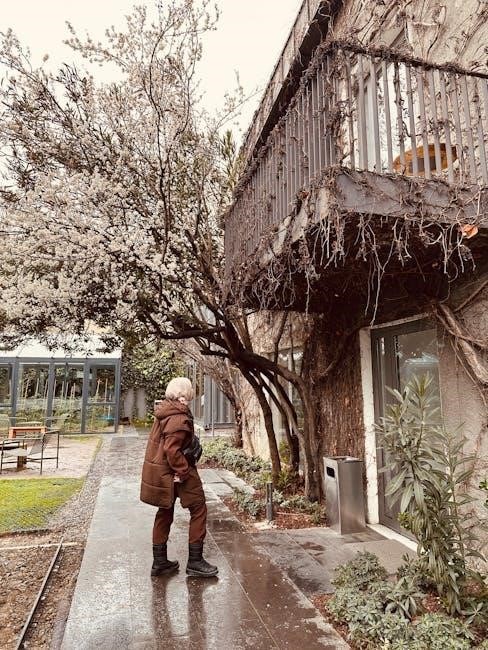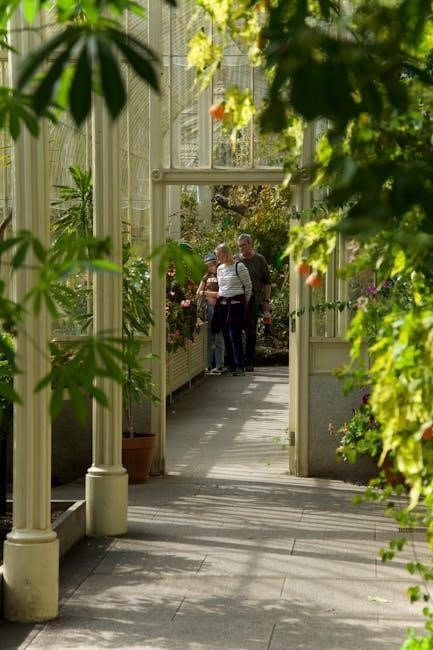Welcome to our guide on assembling a walk-in greenhouse, perfect for beginners and experienced gardeners alike. This project is easy to complete with the right materials and step-by-step instructions, ensuring your greenhouse is both functional and durable. Follow along to learn how to protect your plants and enjoy year-round gardening.
Overview of the Assembly Process
Assembling a walk-in greenhouse is a straightforward process that requires careful planning and organization. The process typically begins with preparing the site and leveling the ground. Next, the base frame is assembled and secured, followed by attaching side panels and vertical supports. The roof structure is then built and covered with the provided material. Finally, the greenhouse is secured with straps and checked for stability. Each step is designed to be manageable, even for beginners, ensuring a durable and functional shelter for your plants. Follow the instructions closely for a successful assembly.
Importance of Following Instructions
Adhering to the provided assembly instructions is crucial for ensuring the structural integrity and functionality of your walk-in greenhouse. Properly following each step guarantees a stable and secure structure, preventing potential issues like leaks or collapse. Instructions are designed to simplify the process, making it accessible to all skill levels. By carefully reading and executing each directive, you can avoid costly mistakes and ensure your greenhouse stands up to weather conditions and lasts for years. Attention to detail and patience are key to a successful assembly and a thriving gardening environment.
Tools and Materials Required
Assembling a walk-in greenhouse requires specific tools and materials to ensure a successful and durable structure. Essential tools include a screwdriver, wrench, pliers, tape measure, and a ladder for reaching high areas. Safety gloves and protective eyewear are recommended. Materials typically provided in the kit include metal poles, plastic connectors, screws, bolts, and the greenhouse cover. Additional items like weatherproof glue, rope, or anchors may be needed for extra stability. Having all tools and materials ready before starting ensures a smooth assembly process and prevents delays.

Preparing for Assembly
Preparation is crucial for a smooth assembly process. Evaluate the site, clear the area, and organize tools and materials. Proper planning ensures efficiency and accuracy.
Choosing the Right Location
Choosing the right location for your walk-in greenhouse is essential for optimal performance. Ensure the area receives adequate sunlight, preferably south-facing for maximum light exposure. The site should be level, well-drained, and protected from strong winds. Avoid low-lying areas prone to waterlogging. Consider proximity to a water source and electrical supply for convenience. Additionally, ensure the location complies with local building codes and regulations. Proper placement will enhance functionality, durability, and overall growing conditions.
Site Preparation and Leveling
Before assembling your walk-in greenhouse, prepare the site thoroughly. Clear the area of debris, vegetation, and obstructions. Check the ground level using a spirit level or similar tool. If necessary, dig slightly uneven areas or fill in low spots with soil or sand to create a stable base. Compact the ground using a hand tamper or rake to ensure firmness. Proper leveling ensures the greenhouse stands evenly, preventing structural issues and ensuring all components fit securely. A well-prepared site guarantees a smooth and successful assembly process.
Unpacking and Organizing Components
Begin by carefully unpacking all components from the greenhouse kit. Check each item against the inventory list to ensure nothing is missing or damaged. Organize parts by type, such as frames, connectors, panels, and hardware, to streamline assembly. Use labels or separate containers to keep small items like screws and bolts accessible. Lay out larger components, like roof and wall panels, in a protected area to prevent damage. This step ensures efficiency and reduces the risk of losing or misplacing critical parts during assembly. Proper organization is key to a smooth and stress-free process.

Understanding the Greenhouse Kit
Understanding the greenhouse kit involves knowing its components and purpose. Kits vary in size and material, offering durability, portability, and easy assembly for gardeners of all levels.
Components of a Typical Walk-In Greenhouse Kit
A typical walk-in greenhouse kit includes a metal or PVC frame, polycarbonate or polyethylene panels, connectors, a roof support system, and a cover. Additional components may include shelves, doors, and vents. The frame provides structural integrity, while the panels offer insulation and UV protection. Connectors ensure secure assembly, and the roof support enhances stability. Some kits also include anchoring systems for wind resistance. Accessories like irrigation kits or shade cloths may be optional. Understanding each part is crucial for efficient assembly and optimal performance.

Reading and Interpreting Assembly Manuals
Reading and interpreting assembly manuals is essential for a successful greenhouse setup. Start by reviewing the manual thoroughly to understand the sequence of steps. Pay attention to diagrams and illustrations, as they provide visual guidance. Organize components and tools beforehand to match the instructions. Look for symbols or labels that indicate specific parts or actions. If unclear, refer to the troubleshooting section or contact customer support. Following the manual step-by-step ensures accuracy and minimizes errors. Take notes if needed, and double-check each part before proceeding to the next. This approach saves time and ensures a sturdy structure.
Identifying Hardware and Connectors
Identifying hardware and connectors is crucial for efficient assembly. Examine the provided bolts, screws, and clips, as they vary in size and function. Use the manual to match each part to its purpose. Categorize items like frame connectors, roof fasteners, and wall brackets. Refer to diagrams to recognize unique or specialized connectors. Labeling parts as you unpack ensures easy access. Check for any missing or damaged components early to avoid delays. Proper identification prevents mismatches and ensures a secure, durable structure. This step sets the foundation for a smooth assembly process.

Assembling the Base Frame
Assemble the base frame by aligning metal poles and securing them with plastic connectors. Use a wrench to tighten bolts firmly, ensuring the frame is square and stable.
Connecting Metal Poles with Plastic Connectors
Start by aligning the metal poles according to the assembly manual. Insert the ends of the poles into the plastic connectors, ensuring they fit snugly. Use a wrench to tighten the bolts securely, making sure the connections are firm. Check that all corners are square and the frame remains level. Properly aligned poles and tightly secured connectors are crucial for the stability of the base frame. Avoid over-tightening, as this may damage the connectors or poles. Continue connecting all poles to form a sturdy foundation for the greenhouse structure.
Ensuring Stability and Levelness
Stability and levelness are critical for the structural integrity of your walk-in greenhouse. Begin by placing a spirit level on the base frame to verify that it is perfectly horizontal. If the frame is uneven, use wooden shims or adjust the base poles slightly to achieve balance. Ensure all corners are at the same height to prevent leaning. Double-check the levelness after making adjustments to confirm accuracy. A stable and level base ensures the greenhouse stands securely and functions properly, preventing potential structural issues during use.
Securing the Base to the Ground
To ensure long-term stability, secure the base frame to the ground using the provided anchors or stakes. For soil, drive metal stakes through pre-drilled holes in the base corners, ensuring they are deeply embedded. On concrete, use anchor bolts or expansion screws. Tighten all hardware firmly to prevent movement. Check the torque specifications in the manual to avoid over-tightening. Properly securing the base protects the greenhouse from wind damage and ensures a solid foundation for the entire structure; Double-check all anchors for tightness before proceeding to the next steps.

Building the Wall Structure
Attach side panels to the base frame, aligning edges carefully. Use provided connectors to secure them tightly. Install vertical supports between panels for added stability. Ensure the structure is square before proceeding to avoid alignment issues later.
Attaching Side Panels to the Base
Align the side panels with the base frame, ensuring edges match pre-drilled holes. Secure panels using bolts or screws provided in the kit. Tighten firmly to maintain stability. If panels are multiple pieces, connect them first before attaching to the base. Ensure a snug fit to avoid gaps. Use a rubber mallet to tap panels into place gently. Double-check alignment before tightening all hardware. Repeat for both sides, working from one end to the other for even weight distribution. Properly attached panels form the structural foundation for the walls and roof.
Installing Vertical Supports
Vertical supports are essential for adding structural integrity to the greenhouse walls. Attach them to the base frame at evenly spaced intervals, following the manual’s specifications. Ensure each support is aligned vertically and securely fastened using bolts or screws provided in the kit. Tighten all hardware firmly to prevent shifting. Double-check the alignment to maintain the greenhouse’s stability and balance. Once installed, the vertical supports will serve as the framework for attaching the roof and other components, ensuring the structure remains sturdy and durable over time.
Connecting the Rear and Front Walls
Align the rear and front walls with the base frame, ensuring they are evenly spaced and symmetrical. Attach the walls using the provided connectors or bolts, following the manufacturer’s instructions. Make sure the corners are securely fastened to maintain structural integrity. Check that the walls are plumb and properly aligned before tightening all hardware. Once connected, the walls should form a sturdy rectangular frame, ready to support the roof and other components. Ensure all gaps are closed for a seamless connection and optimal stability.
Constructing the Roof Frame
Assemble the roof frame by connecting the support beams and ridge poles using the provided connectors. Ensure the structure is sturdy and evenly aligned for stability.
Assembling the Roof Support Structure
Begin by connecting the roof beams to the vertical posts using the provided bolts and connectors. Ensure the structure is square and evenly spaced. Use a level to verify alignment and stability. Tighten all connections firmly to prevent shifting. If using a ridge beam, attach it along the peak of the roof for added support. Double-check the alignment of all components to ensure the roof frame is sturdy and properly shaped. This step is critical for maintaining the structural integrity of the greenhouse and withstanding weather conditions.
Attaching Roof Panels to the Frame
Start by unpacking and cleaning the roof panels to ensure a smooth installation. Align the panels with the roof frame, beginning from the bottom edge and working upwards. Secure each panel using the provided clips, screws, or snap-on connectors, ensuring a snug fit. Tighten evenly to avoid warping the frame. Use weatherproof tape or seals at panel joints for a watertight finish. Double-check alignment and tightness to ensure the panels are securely attached and evenly spaced. This step ensures proper light transmission and structural integrity for the greenhouse.
Ensuring Proper Roof Alignment
Verify the roof frame is square and evenly spaced by measuring diagonals. Use a spirit level to ensure the roof is perfectly horizontal. Check that all roof panels are evenly aligned and seated securely in their channels. Gently tighten connectors to avoid misalignment. Inspect the entire roof structure for symmetry and balance. Make adjustments by loosening and re-tightening connectors as needed. Ensure no panels are overlapping incorrectly or gapping excessively. Finalize by checking the roof’s structural integrity and visual appeal, ensuring it complements the greenhouse’s overall design and functionality.
Securing the Greenhouse Cover

Apply the cover evenly, starting from the roof peak. Use straps to tighten it around the frame. Ensure a snug, waterproof fit by sealing all edges securely.
Applying the Plastic or Polycarbonate Cover
Begin by carefully unfolding the cover and aligning it with the greenhouse frame. Start at the roof peak for even distribution. Ensure the material is smooth and wrinkle-free. Use gloves to prevent scratching polycarbonate panels. If using plastic, secure one edge at a time, working from top to bottom. For polycarbonate, align with pre-drilled holes and gently snap into place. Avoid stretching or forcing the material, as this can cause damage. Use a helper to manage larger covers and ensure proper fit. Temporarily secure with clips or bungee cords before final tightening.
Tightening the Cover with Provided Straps
Once the cover is in place, use the provided straps to secure it tightly. Start from the center and work outward to ensure even tension. Avoid over-tightening, as this may cause the frame to bow or the cover to tear. Check all straps for proper alignment and adjust as needed. Ensure no wrinkles or sagging remains, as this can compromise the greenhouse’s structural integrity. For added security, tighten straps in a crisscross pattern. Finally, inspect the cover’s tightness and make adjustments to ensure a snug, weatherproof fit.
Ensuring a Waterproof Seal
To ensure a waterproof seal, carefully inspect the cover for any gaps or loose areas. Apply sealant tape or weatherproof strips along the edges where the cover meets the frame. Pay special attention to seams and connections. Use the provided clips or straps to reinforce these areas. Regularly inspect the seal for wear or damage, especially after harsh weather. A tight, waterproof seal is crucial for maintaining consistent humidity and preventing leaks, which can damage plants and compromise the greenhouse’s efficiency. Proper sealing also helps reduce heat loss during colder months.
Installing Shelves and Accessories
Assemble shelves according to instructions, place them inside the greenhouse, and secure with support brackets. Install accessories like hooks or hanging systems for additional storage solutions.
Assembling and Placing Shelves
Begin by assembling shelves using the provided hardware, ensuring all pieces fit securely. Follow the manual to attach shelf frames to the greenhouse structure. Place shelves at desired heights, ensuring they are level and stable. Use brackets or screws to secure them firmly to the frame. Make sure shelves are positioned to maximize space without obstructing airflow or light. Double-check the stability of each shelf before adding plants or items.
Adding Support Brackets for Shelves
Attach support brackets to the greenhouse frame using screws or bolts provided in the kit. Ensure brackets are aligned with the shelf edges for even weight distribution. Tighten firmly to prevent shifting. For added stability, place brackets at equal intervals along the shelves. Double-check that brackets are securely fastened to both the frame and shelves. This step ensures shelves remain sturdy and can hold the weight of plants and gardening supplies without sagging or tipping.

Installing Doors and Windows
Begin by aligning the door and window frames with the pre-drilled holes on the greenhouse structure. Secure them using the provided screws or bolts, ensuring they fit snugly. Apply weatherstripping around the edges for a tight seal. Test the door and window mechanisms to ensure smooth operation. Tighten all connections firmly to prevent gaps. For sliding doors, lubricate the tracks for effortless movement. Double-check that windows open and close properly for ventilation. Ensure all hardware is tightly fastened to withstand wind and weather conditions.

Finalizing the Assembly
Double-check all connections and tighten any loose parts. Test the structure’s stability by gently shaking it. Make final adjustments to ensure everything is secure and aligned properly.
Double-Checking All Connections
Ensure all bolts, screws, and connectors are tightly secured. Inspect every joint and frame connection for gaps or misalignments. Use a wrench or screwdriver to tighten any loose parts; Pay special attention to high-stress areas like roof supports and door hinges. Verify that all plastic or metal connectors are fully engaged and not damaged. Double-checking connections ensures the greenhouse’s structural integrity and prevents potential damage from wind or weight. If unsure, consult the manual or manufacturer’s guidelines for specific torque requirements or tightening sequences.
Testing Stability and Durability
Test the greenhouse’s stability by gently shaking the frame to ensure it’s rigid. For durability, inspect for any signs of wear or weaknesses in materials. Check for leaks by spraying water on the roof and walls. Ensure all panels are securely fastened. If possible, simulate light wind conditions to observe any potential sway. Address any issues promptly to maintain structural integrity. Consult the manual for specific durability tests recommended by the manufacturer.
Final Adjustments and Tightening

After completing the assembly, perform a final inspection to ensure all components are properly aligned. Tighten any loose bolts, screws, or connectors to enhance structural integrity. Check that all panels and covers are securely fastened. Adjust any misaligned parts to achieve a flush finish. Refer to the manual for specific torque recommendations. Ensure doors and windows operate smoothly and seal properly. Make any necessary fine-tuning to guarantee the greenhouse is sturdy and ready for use. This step ensures long-term performance and reliability of the structure.
Post-Assembly Tips
- Secure the greenhouse against wind to prevent damage.
- Ensure proper drainage around the base to avoid water pooling.
- Conduct a final inspection and address any issues promptly.
Securing the Greenhouse Against Wind
To protect your walk-in greenhouse from wind damage, ensure it is firmly anchored to the ground using ground anchors or auger anchors. Position the structure in a spot with natural wind protection, such as near a building or behind a row of trees. Tighten the cover securely and consider adding extra support to the frame. Regularly inspect the greenhouse after strong winds to address any potential damage. Proper anchoring and maintenance will help ensure your greenhouse remains stable and secure during harsh weather conditions.
Ensuring Proper Drainage
Proper drainage is essential to prevent water accumulation around your walk-in greenhouse, which can damage the structure or plants. Ensure the site is slightly sloped to allow water to run off naturally. Place gravel or small stones around the base to improve drainage and prevent erosion. Install a drainage system, such as a shallow channel or perforated pipe, to redirect water away from the greenhouse. Regularly inspect and clear debris from drainage paths to maintain efficiency and protect your greenhouse from water-related issues.
Final Inspection and Touch-Ups
After completing the assembly, perform a final inspection to ensure all components are securely fastened and properly aligned. Check for any loose connections, gaps, or misaligned panels; Tighten any bolts or screws that may have come loose during assembly. Inspect the greenhouse cover for wrinkles or tears and smooth them out if necessary. Apply touch-ups to any scratched or damaged surfaces using the provided materials. Ensure all doors and windows open and close smoothly. Finally, verify that all shelves and accessories are securely installed and the greenhouse is ready for use.
